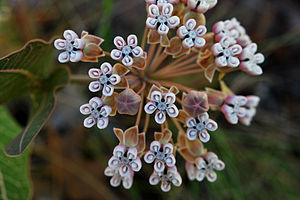Asclepias humistrata
| Asclepias humistrata | ||||||||||||
|---|---|---|---|---|---|---|---|---|---|---|---|---|

Asclepias humistrata |
||||||||||||
| Systematics | ||||||||||||
|
||||||||||||
| Scientific name | ||||||||||||
| Asclepias humistrata | ||||||||||||
| Walter |
Asclepias humistrata is a species of silk plants ( Asclepias ) from the subfamily of the silk plants (Asclepiadoideae).
features
Vegetative characteristics
Asclepias humistrata is a perennial , herbaceous , erect or prostrate plant with a deep, narrow-spindle rootstock. The simple shoots are stiff, 20 to 40 cm (up to 90 cm) high, gray-green and bare. The opposite leaves are sessile. The leaf blades are very broadly ovate and 5 to 12 cm long and 3 to 10 cm wide. The outer end is broadly pointed to obtuse angled, the base deeply heart-shaped and encompassing the stem. They are slightly succulent and bare, the leaf veins stand out clearly from the gray-green basic color of the leaves by their usually reddish or purple color.
Inflorescence and flowers
The little to many-flowered, compact, stalked inflorescences are terminal and usually arise laterally from the uppermost nodes . The slender inflorescence stalks are 4 to 6 cm long. The five-fold hermaphrodite flowers are zygomorphic and have a double flower envelope. The flower stalks are 1 to 3 cm long. The flower is rather small with lanceolate, 2.5 to 3 mm long sepals . The corolla is wheel-shaped with strongly bent back, pink-purple, 5 to 6 mm long petal tips. The single-row, pale cream-colored to purple-colored corolla has a short stalk, the stalk is broadly inverted and measures about 1 mm in length and 1.5 to 2 mm in width. The hood-shaped tips are broadly egg-shaped and about 3 mm long. The horn-shaped secondary process on the inside of the lobes usually rests against the lobes. It is crescent-shaped, slightly shorter than the tip and curved inward. The 1.5 to 2 mm long stylus head is conical in shape with a flattened top.
Fruits and seeds
The narrow, spindle-shaped, paired follicles stand upright and are 9 to 10 cm long and 1.5 to 2 cm thick. The surface is smooth and bare. The seeds are broadly egg-shaped, about 8 mm long and have a white, 3.1 to 3.5 cm long head of hair.
Geographical distribution and (syn-) ecology
The distribution area is essentially in the southeastern United States ( Alabama , Florida , Georgia , Louisiana , Mississippi , North Carolina and South Carolina ). It grows there on sand dunes, dry, light oak forests and light pine forests on well-drained, sandy soils. It blooms from April to July. It is food for the caterpillars of the monarch butterfly ( Danaus plexippus ) and Danaus gilippus as well as the bear moth species Cycnia tenera and Cycnia inopinata .
Taxonomy and systematics
The taxon was first described by Thomas Walter in 1788. André Michaux wrongly described it as Asclepias amplexicaulis . The Plant List accepts the taxon as a valid species. Asclepias humistrata occasionally hybridizes with Asclepias amplexicaulis .
supporting documents
literature
- Mark Hutchinson: Asclepias humistrata - Sandhill Milkweed. Native Plant Owners Manual. Florida Native Plant Society PDF
- Robert E. Woodson, Jr .: The North American Species of Asclepias L. In: Annals of the Missouri Botanical Garden , Vol. 41, No. 1, 1954, pp. 1-211, St. Louis, Mo. URL
- Myron P. Zalucki, Lincoln P. Brower: Survival of first instar larvae of Danaus plexippus (Lepidoptera: Danainae) in relation to cardiac glycoside and latex content of Asclepias humistrata (Asclepiadaceae). In: Chemoecology , Vol. 3, No. 2, 1992, pp. 81-93 doi : 10.1007 / BF01245886 . ISSN 0937-7409 .
- Ronald A. Martin, Steven P. Lynch, Lincoln P. Brower, Stephen B. Malcolm, Tonya Hook: Cardenolide content, emetic potency, and thin-layer chromatography profiles of monarch butterflies, Danaus plexippus, and their larval host-plant milkweed, Asclepias humistrata, in Florida. In: Chemoecology , Vol. 3, No. 1, 1992, pp. 1-13 doi : 10.1007 / BF01261450 . ISSN 0937-7409 .
Individual evidence
- ^ Bring Back The Monarchs - Asclepias humistrata
- ^ William E. Conner: Tiger Moths and Woolly Bears: Behavior, Ecology, and Evolution of the Arctiidae: Behavior, Ecology, and Evolution of the Arctiidae. 328 pp., Oxford University Press, 2008 Online at Google Books (pp. 86, 90)
- ^ Thomas Walter, J. Frazer, J. Wenman: Flora Caroliniana, secundum Systema vegetabilium Linnæi digesta, characteres essentiales naturalesve et differentias veras exhibens; cum emendationibus numerosis, descriptionum antea evulgatarum adumbrationes stirpium plus mille continens, necnon generibus novis non paucis, speciebus plurimis novisq. ornata. Londini: Sumptibus J. Fraser Prostant venales apud J. Wenman, in Vico vulgo dicto Fleet-street, 1788. Online at www.biodiversitylibrary.org (p. 105)
- ^ André (Andreas) Michaux: Flora boreali-americana, sistens caracteres plantarum quas in America septentrionali collegit et detexit. Parisiis et Argentorati, apud fratres Levrault, anno XI - 1803. Online at www.biodiversitylibrary.org (p. 115)
- ↑ Rafael Govaerts (ed.): World Checklist of Selected Plant Families (in review): Asclepias. Published in: The Plant List. A working list of all plant species. Royal Botanic Gardens Kew, Missouri Botanical Garden, accessed May 14, 2013.